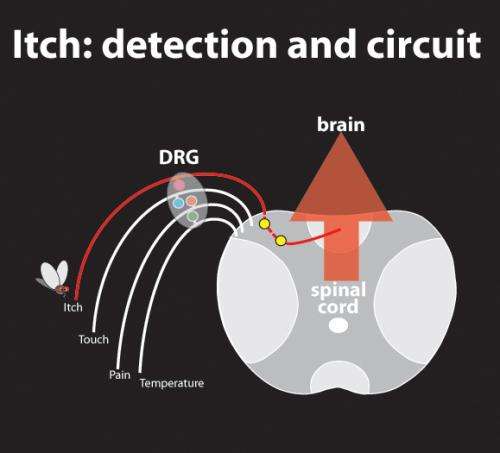Scientists discover molecule triggers sensation of itch

Scientists at the National Institutes of Health report they have discovered in mouse studies that a small molecule released in the spinal cord triggers a process that is later experienced in the brain as the sensation of itch.
The small molecule, called natriuretic polypeptide b (Nppb), streams ahead and selectively plugs into a specific nerve cell in the spinal cord, which sends the signal onward through the central nervous system. When Nppb or its nerve cell was removed, mice stopped scratching at a broad array of itch-inducing substances. The signal wasn't going through.
Because the nervous systems of mice and humans are similar, the scientists say a comparable biocircuit for itch likely is present in people. If correct, this start switch would provide a natural place to look for unique molecules that can be targeted with drugs to turn off the sensation more efficiently in the millions of people with chronic itch conditions, such eczema and psoriasis.
The paper, published online in the journal Science, also helps to solve a lingering scientific issue. "Our work shows that itch, once thought to be a low-level form of pain, is a distinct sensation that is uniquely hardwired into the nervous system with the biochemical equivalent of its own dedicated land line to the brain," said Mark Hoon, Ph.D., the senior author on the paper and a scientist at the National Institute of Dental and Craniofacial Research, part of the National Institutes of Health.
Hoon said his group's findings began with searching for the signaling components on a class of nerve cells, or neurons, that contain a molecule called TRPV1. These neurons, with their long nerve fibers extending into the skin, muscle, and other tissues, help to monitor a range of external conditions, from extreme temperature changes to detecting pain.
Yet little is known about how these neurons recognize the various sensory inputs and, like sorting mail, know how to route them correctly to the appropriate pathway to the brain.
To fill in more of the details, Hoon said his laboratory identified in mice some of the main neurotransmitters that TRPV1 neurons produce. A neurotransmitter is a small molecule that neurons selectively release when stimulated, like a quick pulse of water from a faucet, to communicate sensory signals to other nerve cells.
The scientists screened the various neurotransmitters, including Nppb, to see which ones corresponded with transmitting sensation.
"We tested Nppb for its possible role in various sensations without success," said Santosh Mishra, lead author on the study and a researcher in the Hoon laboratory. "When we exposed the Nppb-deficient mice to several itch-inducing substances, it was amazing to watch. Nothing happened. The mice wouldn't scratch."
Further experiments established that Nppb was essential to initiate the sensation of itch, known clinically as pruritus. Equally significant, the molecule was necessary to respond to a broad spectrum of pruritic substances. Previous research had suggested that a common start switch for itch would be unlikely, given the myriad proteins and cell types that seemed to be involved in processing the sensation.
Hoon and Mishra turned to the dorsal horn, a junction point in the spine where sensory signals from the body's periphery are routed onward to the brain. Within this nexus of nerve connections, they looked for cells that expressed the receptor to receive the incoming Nppb molecules.
"The receptors were exactly in the right place in the dorsal horn," said Hoon, the receptor being the long-recognized protein Npra. "We went further and removed the Npra neurons from the spinal cord. We wanted to see if their removal would short-circuit the itch, and it did."
Hoon said this experiment added another key piece of information. Removing the receptor neurons had no impact on other sensory sensations, such as temperature, pain, and touch. This told them that the connection forms a dedicated biocircuit to the brain that conveys the sensation of itch.
But the scientists had stepped into a conundrum. Previous reports had suggested that another neurotransmitter called GRP might initiate itch. If that wasn't the case, where did GRP fit into the process?
They tested the receptor neurons that express GRP, finding the previous reports were correct about this molecule relaying the signal to the central nervous system. GRP just enters the picture after Nppb already has set the sensation in motion.
Based on these findings, Nppb would seem to be an obvious first target to control itch. But that's not necessarily the case. Nppb also is used in the heart, kidneys, and other parts of the body, so attempts to control the neurotransmitter in the spine has the potential to cause unwanted side effects.
"The larger scientific point remains," said Hoon. "We have defined in the mouse the primary itch-initiating neurons and figured out the first three steps in the pruritic pathway. Now the challenge is to find similar biocircuitry in people, evaluate what's there, and identify unique molecules that can be targeted to turn off chronic itch without causing unwanted side effects. So, this is a start, not a finish."
More information: The paper, published May 24 online in Science, is titled 'The Cells and Circuitry for Itch Responses in Mice'.
















